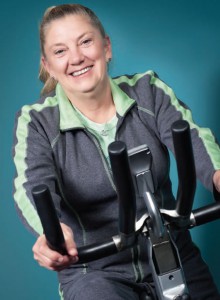About 10 years ago, Linda Moses of Bridgewater, Va., felt something “rip” inside her right knee as she slipped while docking her family’s sailboat off the coast of Charleston, S.C.

Within hours, her knee began swelling, and she was in excruciating pain. She had suffered a complete tear of the anterior cruciate ligament — the knee’s key stabilizing ligament, commonly known as the ACL. Her doctor advised against surgery because Moses isn’t an athlete. Instead, she wore a brace to support her leg.
For 55-year-old Moses — whose busy lifestyle includes swimming, biking and walking — the injury was debilitating. Two years ago, when she fell and further damaged the knee, she decided to pursue ACL reconstruction.
“My knee would sometimes just give out and buckle right under me,” says Moses, who underwent surgery at UVA in January. “I didn’t want to live like that. I wanted to stay active. And I kept worrying about what would happen to my knee as I got older, if I didn’t take care of it.”
ACL Tears: A Common Knee Injury
Although ACL tears occur most frequently in athletes whose sports involve running, jumping and cutting — like basketball and soccer — anyone is at risk.
In fact, the American Academy of Orthopaedic Surgeons estimates that nearly 200,000 ACL injuries occur each year in the United States, with nearly 100,000 ACL reconstructions performed annually.
The ACL typically is injured in noncontact situations — such as stopping suddenly, landing awkwardly from a jump or changing direction rapidly. When the ACL tears, a person most often will feel or hear a “pop.” The resulting pain and swelling eventually subside, but the knee may continue to feel wobbly.
“With an ACL-deficient knee, patients are likely to experience ‘giving way,’ even with normal activities of daily living, and especially with any pivoting activities,” says UVA orthopedic surgeon Mark Miller, MD, who performed Moses’ surgery and is ranked among the 70 best knee surgeons in America, according to the publication Becker’s Orthopedic & Spine Review.
The Female ACL
Female athletes are up to seven times more likely than males to have an ACL injury, according to UVA orthopedic surgeon David Diduch, MD.
Here are some possible reasons:
- Architecture: The body framework may be partly to blame. The notch in the knee where the ACL is located is narrow in women, Diduch says. Also, women have proportionally wider hips than men, creating potential alignment problems.
- Technique: Some studies say females have different movement patterns than men, likely because of their structural differences. Women’s knees are naturally more L-shaped, or knock-kneed.
- Hormones: Estrogen may affect the ACL, making it more prone to injury at certain points during a woman’s monthly cycle.
Avoiding Permanent Damage with ACL Reconstruction
A torn ACL can’t heal on its own. Physical therapy or leg braces may work for elderly patients or those who lead sedentary lifestyles. But without surgical repair, the ligament and surrounding cartilage are at high risk for further damage that may lead to late arthritis.
ACL reconstruction is an arthroscopic surgery where the surgeon makes tiny incisions in the knee and inserts a pencil-sized scope equipped with a small camera and light. Magnified images displayed on a television screen allow the surgeon to see inside the patient’s knee. Patients usually go home the same day. Rehabilitation to retrain and strengthen the muscles begins the next day, and athletes typically resume play six months later.
Moses is pleased with her surgery results and has gradually increased her level of activity, including biking.
“I’m really glad I had the surgery,” Moses says. “Dr. Miller and everyone at UVA have been great. I’m not an athlete, but I’m very active, so I thought this was the best route to go.”
Tired of Instability?
Doctors at UVA’s Sports Medicine Clinic see a lot of patients with knee injuries, including torn ACLs.